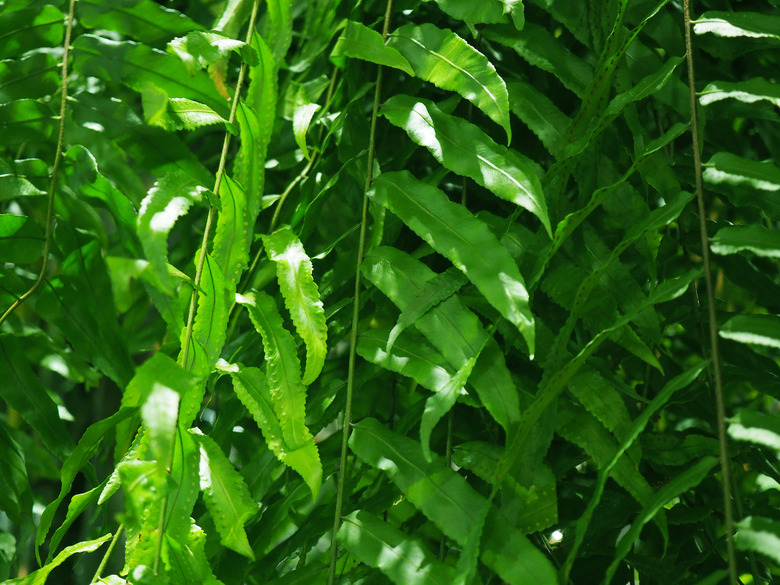How To Care For Macho Ferns
We may receive a commission on purchases made from links.
If you enjoy growing ferns and have room to spare, give a Macho fern (Nephrolepsis biserrta 'Macho') a place in your garden or indoor environment. It can grow outdoors year round in U.S. Department of Agriculture plant hardiness zones 9 through 10, either in the ground or potted, and can also do well grown indoors as a large houseplant in any region. A tropical, evergreen fern, it's also called "giant sword fern" because its sword-shaped fronds can be 4 feet long, with the entire plant approaching a width of 6 feet. Macho fern needs care typical for most ferns — partial shade, moist soil and some extra care now and then.
Macho Fern Light and Soil Requirements
Macho Fern Light and Soil Requirements
A Macho fern needs light shade for best growth; too much sun can scorch the fronds and slow overall growth. If you grow this fern in the ground, the best spot is under tall trees that provide shifting shade throughout the day. For a potted fern, keep it on a covered porch or beneath a building overhang, where it's mostly shaded and gets no more that a bit of morning or late-afternoon sun.
If you grow a macho fern indoors, give it a spot that gets bright, filtered light — a few feet from a lightly curtained, west- or south-facing window is ideal. Never expose the plant to direct, mid-day sun, which can burn its foliage.
This fern grows in any type of garden soil, including sandy or rocky soils, and can tolerate poor drainage or even flooding for short periods, provided the flooding water is fresh and not brackish or salt-laden. It does best when the top layer of soil is rich in organic material, such as humus. You can increase your soil's organic content by spreading 1 or 2 inches of humus — available at garden centers — under the plant each spring when new growth begins.
Tip
If you grow a Macho fern in a container, never use garden soil because it can harbor insect eggs and disease organisms. Always use commercial potting soil.
Watering and Fertilizing Macho Ferns
Watering and Fertilizing Macho Ferns
A Macho fern doesn't tolerate dryness well — a period of drought can cause foliage to dry and might permanently injure the plant. For best results, keep the plant's soil evenly moist, providing water whenever the top of the soil is dry to the touch. If you grow the fern in a container, only use one with at least one drainage hole, and allow the pot to drain fully when watering; never let it stand in a water-filled saucer.
Like most ferns, it also prefers a humid environment and benefits from frequent misting, either outdoors or indoors as a houseplant. It also helps to keep the plant's pot in a pebble-filled saucer or tray, with water added to just below the pebble tops; this is especially beneficial when it's grown in a dry, indoor environment.
Tip
If an indoor-grown Macho fern looks pale, with light green foliage, put it outdoors in a shady, sheltered spot for rejuvenation during the summer.
Feeding a Macho fern when it's actively growing also helps boost the plant's growth. Use a water-soluble, 20-20-20 formula, diluted at about half strength, or 1/4 teaspoon per gallon of water, but check your product label for further directions. Fertilize a new plant every four to six weeks, starting in the spring when you see small new fronds appear; feed an established plant once yearly in spring when growth starts. Only fertilize when soil is moist, to avoid burning the roots.
Warning
If tips of fronds on a potted fern start to brown, check the soil surface for a buildup of fertilizer salts; leach the soil to remove these salts by flooding it with water.
Avoiding Macho Fern Problems
Avoiding Macho Fern Problems
The Macho fern, like most ferns, is usually free of any significant disease problems. Fungal problems are best avoided by providing even soil moisture and avoiding wetting foliage when watering by using drip irrigation or a soaker hose. If a fungal disease develops, usually signaled by dark spots or browning of fronds, it's best to discard the plant.
Pest problems are also rare for this plant, but inspect plants at nurseries carefully for any signs of insects — scale insects resemble dark spots on fronds, while mealybugs are white and fluffy — and avoid purchasing these. If you see scale insects on a fern you're growing, hand-pick these to control them. Treat mealybugs by spraying the fern until dripping wet with insecticidal soap. Repeat every two weeks as needed.
Tip
A macho fern doesn't need regular pruning, but you can help keep a plant tidy by trimming away any fronds that dry up or become damaged. Use sharp shears, wiping them with rubbing alcohol between cuts to prevent spreading plant diseases.
It's possible that temperatures might fall below freezing for short periods in this fern's range. If you expect a cold snap, move a potted fern to a warm spot, such as near a south-facing building wall or into a heated garage. For a fern in the ground that's not too large, covering it with a light cloth can provide protection from cold. If the fern is too large to cover, hang a few lighted lamps or bulbs on larger fronds to provide some warmth.
